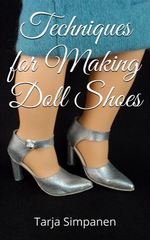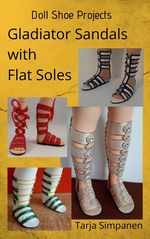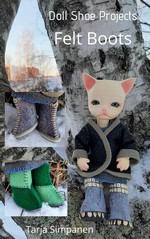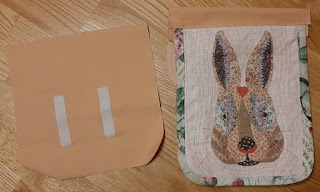I managed to finish the lower pockets of the vest this week. Or not quite, two corners of each pocket still need a bit of stitching, but my sewing machine isn't powerful enough to do it as there are so many layers of fabric there. So that'll have to wait until I get to the school's sewing machine on Monday.
The structure of the pocket is such that there are two pockets in one. A flat one in front and a bit deeper one behind it. Here you can see the almost finished pocket. The front pocket is accessed from the top, under the flap, and the back pocket through the opening on the side that has a zipper.
I'm giving here the basic instructions, explaining the order of things, but not all details, because a lot depends on the thickness of the fabrics you're using. I had to do some tweaking in the corners to minimize the layers of fabric, but with different kinds of fabrics, those things probably would not have been necessary.
To begin with, you need two identical parts for the pocket, one made of the outside fabric, another made of the lining fabric. Turn the upper edge of the outer part and sew it. At this stage, the inner part should be 1 cm (seam allowance) higher than the outer part.
Sew the pieces together with a narrow strip of the lining fabric in between (this part can be seen from the outside when accessing the zipper pocket). The original vest had black lining, which looked the same on both sides, but in my version it took some thought to figure out which way the lining fabric used inside the pocket should be facing. When sewing the vertical seam that attaches the pieces together here, the inner and outer parts should have the right side facing up with the inner part on top of the outer part, while the strip in between them should be the right side down. Lay the pieces flat, turn the strip on top of the inner part, turn the edge of the strip under and stitch near the edge.

The next step is to sew the zipper. It should be entirely under the edge of the fabric, so it stays out of sight. It needs to be sewn with the right side of the outer part facing up, so you're basically going blind, but it is fairly easy to feel the zipper underneath. You just need to be very careful, if you're using a metal zipper, so you don't break the needle when sewing the horizontal part at the bottom. Here you can also see how the narrow strip in the previous picture shows to the outside.
The next step is the side of the back pocket. Sew it in place, turn the right side out, iron flat and stitch near the edge. Note that when you're stitching the upper corner, you need to first turn the seam allowance of the inner part as shown in the picture.
Turn and iron the seam allowances of the other edge. Draw the shape of the pocket to the fabric to which you're sewing the pocket, so you get the edges of the side to the correct place (to get the curved parts identical in both pockets), and sew the pocket in place. Start with the zipper, then the upper edge (the lining fabric, this is why the inner part needs the seam allowance to go 1 cm above the upper edge of the outer part) and finally the edges of the side piece. Stitch the corners neat and flat.
To get the pockets straight, you can either measure from the bottom edge or the vertical middle, but in this case, I used the fabric patterns, because anything else would have looked strange.
The very final part will be to add buttons, but that also requires machines I only have access to at school, so it'll be done later.















































